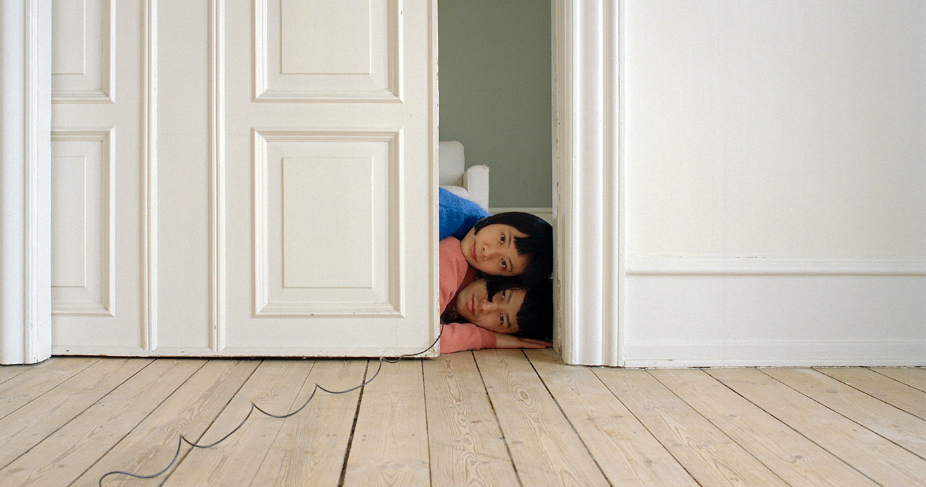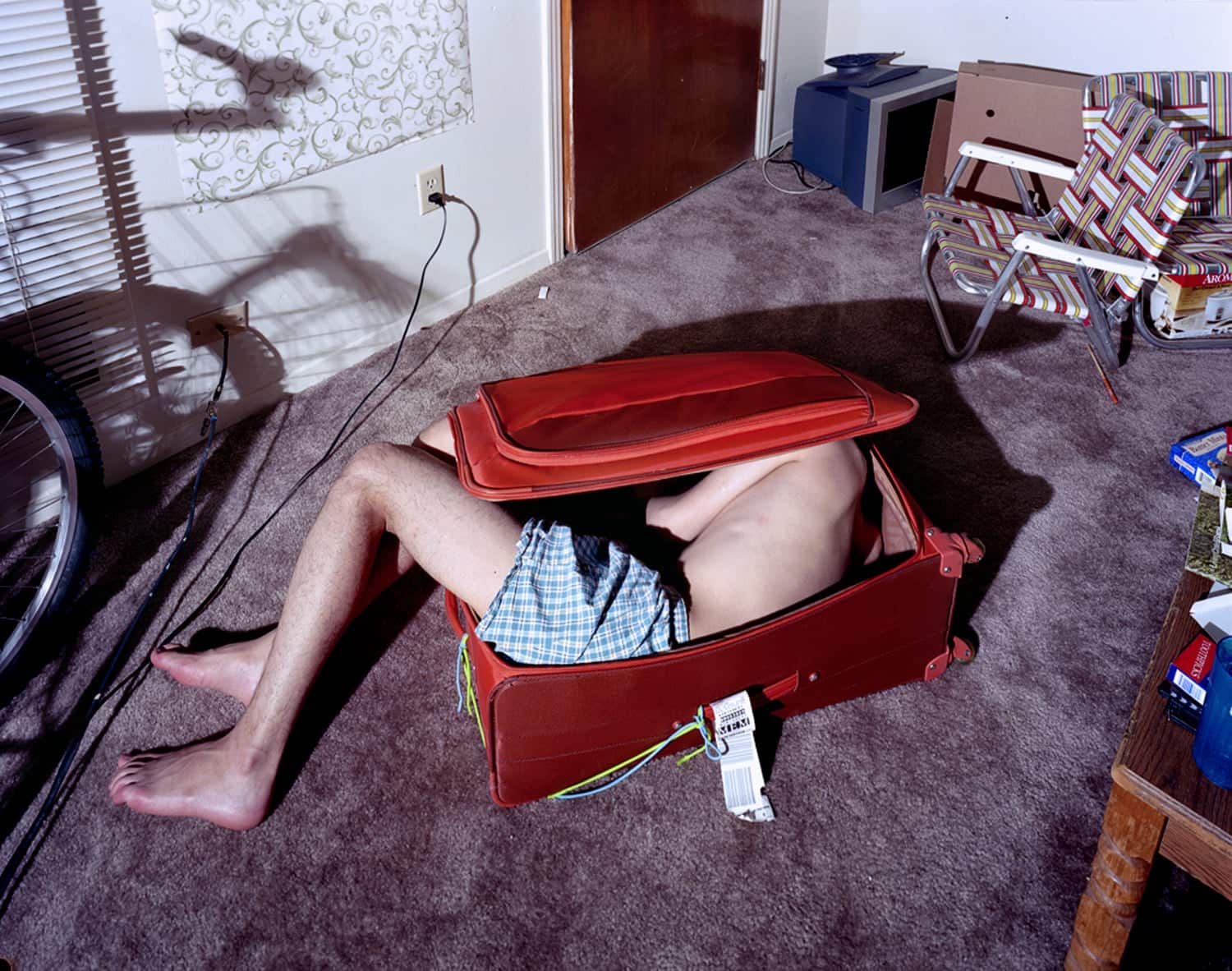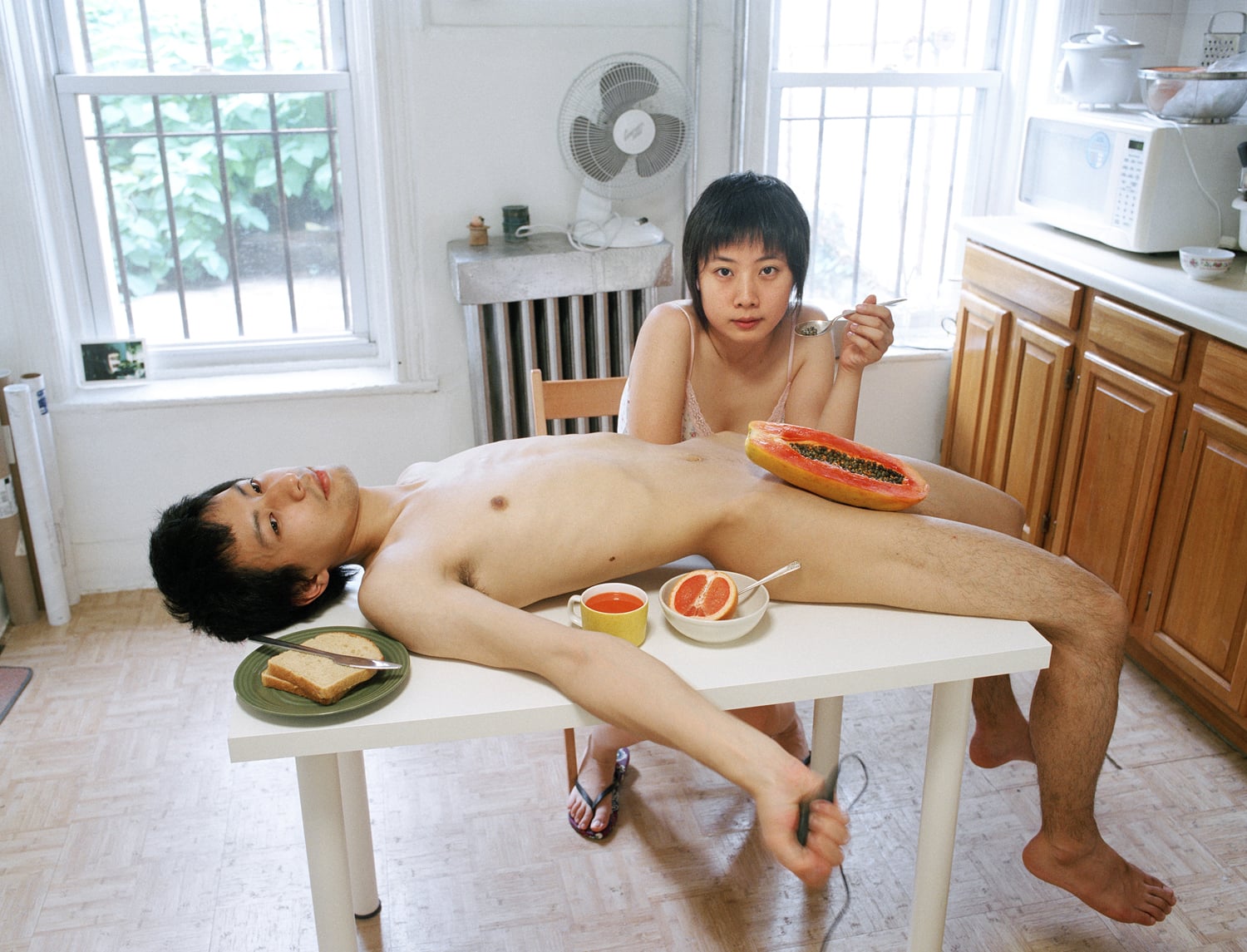
Pixy Liao – Art as Adventure
Theresia Stipp
EN
What adventure is hidden in a photograph? Where does a single image lead us? Pixy Liao’s early photograph The Suitcase (2006) can tell us about this.
The photo shows a man dressed only in boxer shorts, crawling head-first into a red wheeled suitcase with the stickers of the last flight still attached. The suitcase lies in a carpet-covered room in which objects such as a bicycle, an old television, and cardboard boxes remind you of a storage room. Made while still studying at the University of Memphis, this picture caused a storm of indignation among Pixy Liao's fellow students. The image shows Liao’s partner Takahiro Morooka, and she was criticized – so the artist tells us – that she should not show her partner in that way, so weak and fragile. For Pixy Liao this was the starting point that lead to her now well-known series Experimental Relationship (Since 2007).
Experimental Relationship is a series of photographs that examines normativity in heterosexual relationships. The photographs mainly show the artist and her partner in various, often absurd interactions, in which she plays a dominant role. The work has a biographical starting point and examines the actual relationship between the artist and her younger partner. However, if you fail to see beyond the biographical referentiality of the photographs you will misunderstand their scope and narrative potential.
Pixy Liao's photographs are deliberately staged. They follow a tradition of photography that has developed since the late 1970s with artists such as Cindy Sherman, Jeff Wall or Francesca Woodman as a concise, counter-documentary position within photography. As these artists, Liao makes the staging itself subject of the image. None of the images leaves any doubt that this is a posed photo. It is not an image of a reality, but creates its own reality. The picture demands to be read.
For example, there is the picture Start your day with a good breakfast together (2009), in which he lies naked on a kitchen table as part of the breakfast buffet while she spoons a papaya from his lap. Her look goes into the camera in a challenging way and thus to the viewer, as if she wanted to ask whether this was not his or her idea of a "breakfast together".
What becomes clear here – and perhaps the outrage of the fellow students at The Suitcase can also be contextualized there – is a decidedly female gaze on the male body. Even though Pixy Liao does not see herself as a feminist artist – after all, she is not concerned with equality in her pictures, but with dominance, she says – this is about a reversal of the male gaze, which is normative in our visual world.
In a playful, erotic manner, she directs the camera at her partner's naked body, thus revealing the power of gaze relationships. Only in one detail, which appears as a leitmotif in the series, does Liao give up part of her power. The man holds the remote release in his hand and thus has the power to decide on the 'decisive moment' of releasing the shutter.
For The Things I Tell You Will Not Be Wrong Pixy Liao took a new look at her own work to create an online-exhibition titled Choose Your Own Adventure. Together with the curators, she selected 18 photographs from various series and works, including Experimental Relationship and its expansion Four Your Eyes Only. She combined them to a Choose-Your-Own-Adventure-Story, as known from adventure books, to create a new participatory exhibition.
Again, The Suitcase is the starting point. In a radical step, she strips the work of its title and replaces it with the invitation to enter into a story, an adventure:
„You found an unidentified body in an orange suitcase. Your first thought is:
a Who is this person
b Whose suitcase is this
c This room looks messy”
The viewing of the photographs is now guided by the three options a b c. It is almost a detective-like looking, searching for clues as to what might have happened here and how things might continue. Liao draws our attention to the narrative potential of her photographs. She makes visible how photographs always suggest a before and after, as they capture a brief moment in time. She herself adds possible befores and afters from her own photographs and incorporates them into different narratives whose course depends on the decisions of the viewer.
At the same time, this procedure takes the place of its presentation into account – the Internet. Choose Your Own Adventure is a site-specific work. It reflects the movements one makes as an Internet user: the searching and clicking, the back and forth, the dead ends, up to the end of a search. It is a playful reconsideration of her own work as a conscious counter-design to the omnipresent online exhibition as a picture gallery.
DE
Welches Abenteuer verbirgt sich hinter einer Fotografie? Wohin kann uns ein einzelnes Bild führen? Die frühe Arbeit The Suitcase (2006) von Pixy Liao kann davon erzählen.
Das Foto zeigt einen nur mit Boxershorts bekleideten Mann, der mit dem Kopf zuerst in einen roten Rollkoffer gekrochen ist, an dem noch die Aufkleber der letzten Flugreise kleben. Der Koffer liegt in einem teppichbezogenen Zimmer, in dem angeschnittene Gegenstände, wie ein Fahrrad, ein alter Fernseher und Pappkartons, an einen Abstellraum denken lassen. Noch während des Studiums an der University of Memphis entstanden, löste dieses Bild einen Sturm der Empörung bei den Kommiliton*innen aus. Das Bild zeigt Liaos Partner Takahiro Morooka und man kritisierte – so erzählt es die Künstlerin – dass man seinen Partner doch nicht so schwach und zerbrechlich zeigen könne. Für Pixy Liao war dies der Ausgangspunkt, der zu ihrer Serie Experimental Relationship (seit 2007) führte.
Experimental Relationship ist eine Serie von Fotografien, die die Rollenzuschreibungen in heterosexuellen Paarbeziehungen untersucht. Die Fotografien zeigen meist die Künstlerin und ihren Partner in verschiedenen, oft absurden Interaktionen, wobei sie eine dominierende Rolle einnimmt. Die Arbeit ist zunächst biografisch motiviert und untersucht die tatsächliche Beziehung der Künstlerin mit ihrem jüngeren Partner. Wer jedoch nicht über den biografischen Wirklichkeitsbezug der Fotografien hinaussehen kann, missversteht ihre Reichweite und ihr erzählerisches Potential.
Pixy Liaos Fotografien sind bewusst inszeniert. Sie stehen in einer Tradition der Fotografie, die sich seit Ende der 1970er Jahren mit Künstler*innen wie Cindy Sherman, Jeff Wall oder Francesca Woodman als prägnante, kontra-dokumentarische Haltung innerhalb der Fotografie entwickelte. Wie dort ist bei Liao die Inszenierung selbst Thema des Bildes. Keines der Bilder lässt einen Zweifel daran, dass es sich hier um ein gestelltes Foto handelt. Es ist nicht Abbild einer Realität, sondern kreiert seine eigene Wirklichkeit. Das Bild fordert ein, gelesen zu werden.
Da ist zum Beispiel das Bild Start your day with a good breakfast together (2009), in dem er nackt als Teil des Frühstücksbuffets auf einem Küchentisch liegt, während sie eine Papaya von seinem Schoß löffelt. Ihr Blick geht herausfordernd in die Kamera und damit zum*r Betrachter*in, als wollte sie fragen, was denn seine*ihre Vorstellung von einem „gemeinsamen Frühstück“ sei.
Was hier deutlich wird – und dort ist vielleicht auch die Empörung der Kommiliton*innen gegenüber The Suitcase einzuordnen – ist ein dezidiert weiblicher Blick auf den männlichen Körper. Auch wenn Pixy Liao sich nicht als feministische Künstlerin versteht – ihr gehe es in ihren Bildern ja nicht um Gleichberechtigung, sondern um Dominanz, sagt sie – geht es hier doch um eine Umkehrung des in unserer Bilderwelt normativen männlichen Blicks. In spielerisch-erotischer Manier richtet sie die Kamera auf den nackten Körper ihres Partners und legt so die Macht von Blickbeziehungen offen. Nur in einem Detail, das leitmotivisch in der Serie auftaucht, gibt Liao einen Teil ihrer Macht ab. Der Mann hält den Fernauslöser in der Hand und erhält so die Entscheidungsgewalt über den ‚entscheidenden Moment‘ des Auslösens.
Für The Things I Tell You Will Not Be Wrong setzte sich Pixy Liao neu mit ihren eigenen Arbeiten auseinander und entwickelte eine Online-Ausstellung mit dem Titel Choose Your Own Adventure. Gemeinsam mit den Kurator*innen wählte sie 18 Fotografien aus unterschiedlichen Serien und Arbeiten aus, darunter Experimental Relationship und deren Erweiterung Four Your Eyes Only. Diese fügte sie in Form einer Choose-Your-Own-Adventure-Story, wie man sie von Abenteuerbüchern kennt, zu einer neuen partizipatorischen Ausstellung zusammen.
Wieder ist The Suitcase der Ausgangspunkt. In einem radikalen Schritt entzieht sie dem Bild seinen Titel und ersetzt ihn durch die Aufforderung, in eine Geschichte, ein Abenteuer, einzusteigen:
„You found an unidentified body in an orange suitcase. Your first thought is:
a Who is this person
b Whose suitcase is this
c This room looks messy”
Das Betrachten der Fotografien wird nun durch die Entscheidungsmöglichkeiten a b c geleitet. Es ist fast ein detektivisches Schauen, das nach Hinweisen sucht, was hier wohl passiert ist und wie es wohl weitergehen könnte. Liao lenkt unsere Aufmerksamkeit auf das erzählerische Potential ihrer Fotografien. Sie macht sichtbar, wie Fotografien stets ein Davor und Danach suggerieren, da sie einen kurzen Moment im Verlauf der Zeit festhalten. Sie fügt selbst mögliche Davors und Danachs aus ihren eigenen Fotografien hinzu und bindet sie in unterschiedliche Erzählungen ein, deren Verlauf von den Entscheidungen des*der Betrachter*in abhängt.
Gleichzeitig nimmt diese Verfahrensweise den Ort der Präsentation mit in den Blick – das Internet. Choose Your Own Adventure ist eine ortsspezifische Arbeit. Sie reflektiert die Bewegungen, die man als Internetnutzer*in vollführt: das suchende Klicken, das Vor und Zurück, die Sackgassen, bis hin zum Ziel einer Recherche. Es ist eine spielerische Neubetrachtung der eigenen Arbeit als bewusster Gegenentwurf zur allgegenwärtigen Online-Ausstellung als Bildergalerie.

